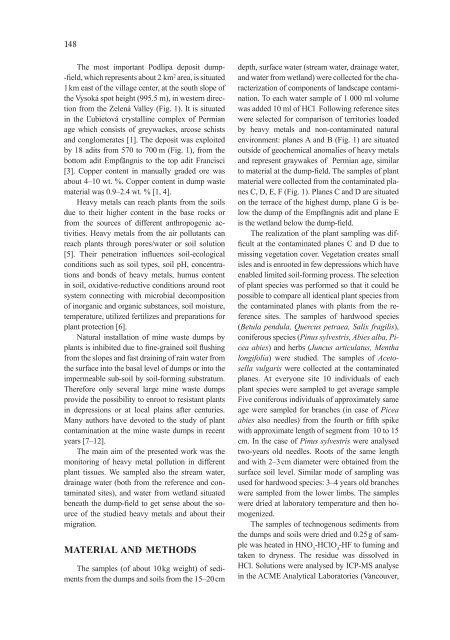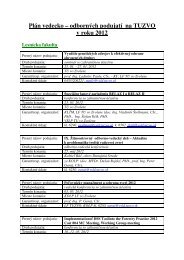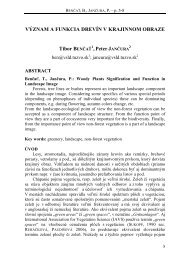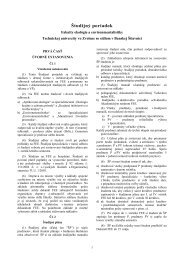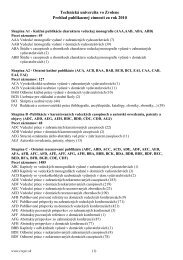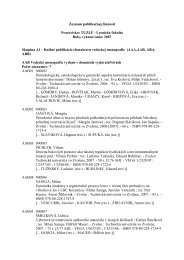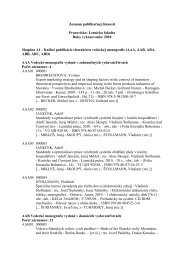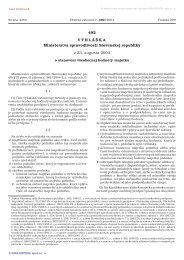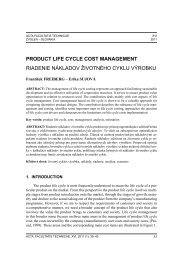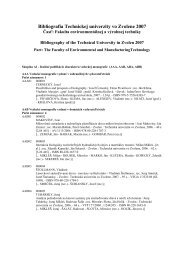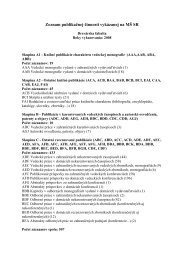147ACTA FACULTATIS ECOLOGIAE, 16: Suppl. 1, 147–158 Z<strong>vo</strong>len (Slovakia), 2007INFLUENCE OF THE DUMP SITES ON DEVELOPMENTOF SELECTED PLANT TISSUES AT THE ĽUBIETOVÁ AREA(SLOVAKIA)Peter Andráš 1,2 − Miroslava Mamoňová 3 − Juraj Ladomerský 4 − Ingrid Turisová 2− Adam Lichý 5 − Jana Rusková 61Geological Institute, Slovak Academy of Sciences, Severná 5, 974 01 Banská Bystrica, Slovakia,andras@savbb.sk2Department of Environmental Management, Faculty of Natural Sciences, Matej Bel University, Tajovského 40,974 01 Banská Bystrica, Slovakia, turisova@fpv.umb.sk3Department of Wood Science, Faculty of Ecology and Environment, Technical University Z<strong>vo</strong>len,T. G. Masaryka 24, 960 53 Z<strong>vo</strong>len, Slovakia, mamonova@vsld.tuz<strong>vo</strong>.sk4Department of Environmental Engineering, Faculty of Ecology and Environmental Sciences,Technical University Z<strong>vo</strong>len, T. G. Masaryka 24, 960 53 Z<strong>vo</strong>len, Slovakia, ladomer@vsld.tuz<strong>vo</strong>.sk5Envigeo, Kynceľová 2, 974 11 Banská Bystrica, Slovakia, lichy@envigeo.sk6Regionálny úrad verejného zdra<strong>vo</strong>tníctva, Cesta k nemocnici 1, 974 01 Banská Bystrica, jana.ruskova@vzbb.skABSTRACTAndráš P., Mamoňová M., Ladomerský J., Turisová I., Lichý A. & Rusková J. Influence of the DumpSites on Development of Selected Plant Tissues at the Ľubietová Area (Slovakia)Natural installation and development of plant species such as Pinus sylvestris, Betula pendula, Quercuspetraea, Salix fragilis, Mentha longifolia, Acetosella vulgaris, Juncus articulatus can be observed atthe old mine waste dumps in the Ľubietová – Podlipa (Zelená Valley, Slovakia) area, specific to the localchemical conditions such as low content of essential nutrients and high content of heavy metals (Fe, Cu,As, Sb, Cd and others). Content of heavy metals and landscape features of the dump material are not appropriatefor the vegetation development. The individual parts of the plant tissues (roots, branches/stems,leaves/needles, flowers/fruits) are contaminated by heavy metals and tissues are damaged differently, respectively.Key words: mining dumps, heavy metals, contamination of plant tissuesINTRODUCTIONFirst written evidence about mining activity inthe Ľubietová area came from the Anjou monarchytime in 1340 [1]. Ľubietová deposit was historicallyimportant by mining of copper ores. Gold was obtainedin small amount as well. The biggest boomof mining activity was in the fifteenth and the sixteenthcentury and lasted for almost 200 years. Thisperiod ended by Turkish invasions in 1571–1588.In the eighteen century, iron became the main componentfor mining production.The revival of mining activity was in 1810 andthe attenuation in 1863. In the period 1860–1870decline of the European copper mining activity dueto competition of oversea ore deposits caused thestopping of mining activity in the Ľubietová areafor more than 100 years and mining dumps wereinteresting only for researchers and mineral collectors[2]. Hydrothermal ore mineralization is e<strong>vo</strong>lvedat 3 deposits: Podlipa in the east border of village,Svätodušná and Kolba in the closure of the PekloValley, 5 km east of village where cobalt, silver andnickel are observed besides iron and copper.
148The most important Podlipa deposit dump--field, which represents about 2 km 2 area, is situated1 km east of the village center, at the south slope ofthe Vysoká spot height (995.5 m), in western directionfrom the Zelená Valley (Fig. 1). It is situatedin the Ľubietová crystalline complex of Permianage which consists of greywackes, arcose schistsand conglomerates [1]. The deposit was exploitedby 18 adits from 570 to 700 m (Fig. 1), from thebottom adit Empfängnis to the top adit Francisci[3]. Copper content in manually graded ore wasabout 4–10 wt. %. Copper content in dump wastematerial was 0.9–2.4 wt. % [1, 4].Heavy metals can reach plants from the soilsdue to their higher content in the base rocks orfrom the sources of different anthropogenic activities.Heavy metals from the air pollutants canreach plants through pores/water or soil solution[5]. Their penetration influences soil-ecologicalconditions such as soil types, soil pH, concentrationsand bonds of heavy metals, humus contentin soil, oxidative-reductive conditions around rootsystem connecting with microbial decompositionof inorganic and organic substances, soil moisture,temperature, utilized fertilizes and preparations forplant protection [6].Natural installation of mine waste dumps byplants is inhibited due to fine-grained soil flushingfrom the slopes and fast draining of rain water fromthe surface into the basal level of dumps or into theimpermeable sub-soil by soil-forming substratum.Therefore only several large mine waste dumpsprovide the possibility to enroot to resistant plantsin depressions or at local plains after centuries.Many authors have de<strong>vo</strong>ted to the study of plantcontamination at the mine waste dumps in recentyears [7–12].The main aim of the presented work was themonitoring of heavy metal pollution in differentplant tissues. We sampled also the stream water,drainage water (both from the reference and contaminatedsites), and water from wetland situatedbeneath the dump-field to get sense about the sourceof the studied heavy metals and about theirmigration.MATERIAL AND METHODSThe samples (of about 10 kg weight) of sedimentsfrom the dumps and soils from the 15–20 cmdepth, surface water (stream water, drainage water,and water from wetland) were collected for the characterizationof components of landscape contamination.To each water sample of 1 000 ml <strong>vo</strong>lumewas added 10 ml of HCl Following reference siteswere selected for comparison of territories loadedby heavy metals and non-contaminated naturalenvironment: planes A and B (Fig. 1) are situatedoutside of geochemical anomalies of heavy metalsand represent graywakes of Permian age, similarto material at the dump-field. The samples of plantmaterial were collected from the contaminated planesC, D, E, F (Fig. 1). Planes C and D are situatedon the terrace of the highest dump, plane G is belowthe dump of the Empfängnis adit and plane Eis the wetland below the dump-field.The realization of the plant sampling was difficultat the contaminated planes C and D due tomissing vegetation cover. Vegetation creates smallisles and is enrooted in few depressions which haveenabled limited soil-forming process. The selectionof plant species was performed so that it could bepossible to compare all identical plant species fromthe contaminated planes with plants from the referencesites. The samples of hardwood species(Betula pendula, Quercus petraea, Salix fragilis),coniferous species (Pinus sylvestris, Abies alba, Piceaabies) and herbs (Juncus articulatus, Menthalongifolia) were studied. The samples of Acetosellavulgaris were collected at the contaminatedplanes. At everyone site 10 individuals of eachplant species were sampled to get average sampleFive coniferous individuals of approximately sameage were sampled for branches (in case of Piceaabies also needles) from the fourth or fifth spikewith approximate length of segment from 10 to 15cm. In the case of Pinus sylvestris were analysedtwo-years old needles. Roots of the same lengthand with 2–3 cm diameter were obtained from thesurface soil level. Similar mode of sampling wasused for hardwood species: 3–4 years old brancheswere sampled from the lower limbs. The sampleswere dried at laboratory temperature and then homogenized.The samples of technogenous sediments fromthe dumps and soils were dried and 0.25 g of samplewas heated in HNO 3-HClO 4-HF to fuming andtaken to dryness. The residue was dissolved inHCl. Solutions were analysed by ICP-MS analysein the ACME Analytical Laboratories (Vancouver,
- Page 2 and 3:
Acta FacultatisEcologiaeJournal of
- Page 4 and 5:
OBSAH / CONTENTSISOL M., MICHALÍKO
- Page 6:
5ACTA FACULTATIS ECOLOGIAE, 16: Sup
- Page 12:
11ACTA FACULTATIS ECOLOGIAE, 16: Su
- Page 18 and 19:
17ACTA FACULTATIS ECOLOGIAE, 16: Su
- Page 20 and 21:
19are lower in ill patients compare
- Page 22:
21are considered as the most accura
- Page 25 and 26:
24- multimode cavities are usually
- Page 27 and 28:
26the load during its exposure to f
- Page 29 and 30:
28Tradescantia paludosa 02 test and
- Page 31 and 32:
30Tab. 5: Results of positive contr
- Page 34 and 35:
33ACTA FACULTATIS ECOLOGIAE, 16: Su
- Page 36 and 37:
35DISCUSSIONThe ionising radiation
- Page 38 and 39:
37ACTA FACULTATIS ECOLOGIAE, 16: Su
- Page 40 and 41:
39222Rn is produced by radioactive
- Page 42 and 43:
41180160140this reason we also pick
- Page 44:
435001450400350hKz0,8h [m]300250200
- Page 47 and 48:
46deposit is that stripped in off-l
- Page 49 and 50:
48TruenessTrueness was determined i
- Page 51 and 52:
50MATERIAL AND METHODSChloroform (p
- Page 53 and 54:
52absorbance [a.u.]1,000,750,500,25
- Page 55 and 56:
54Tab. 1: Rrequirements determinati
- Page 57 and 58:
56Methods of VOC testing were set a
- Page 60 and 61:
59Tab. 6: ContinuedSamples withsurf
- Page 62 and 63:
61ACTA FACULTATIS ECOLOGIAE, 16: Su
- Page 64 and 65:
63One of the possible explanations
- Page 66 and 67:
65Ai - Ai-1 [Bq.m -3 ]86420-2-4-6-8
- Page 68 and 69:
67ACTA FACULTATIS ECOLOGIAE, 15: Su
- Page 70 and 71:
69BiodegradabilityThe great variety
- Page 72 and 73:
71degradation starts of late days,
- Page 74 and 75:
73Fig. 4 Treated (after 28 days of
- Page 76:
75parameters of the cutting process
- Page 80 and 81:
79Fraction: D (residual rest) prese
- Page 82:
81was not confirmed. Maximum of mer
- Page 85 and 86:
84Fig. 1 Schematic diagram of atomi
- Page 87 and 88:
86Alpha spectrometryAlpha spectrome
- Page 89 and 90:
8880007000y = 6622xR 2 = 0.939SIMS
- Page 92 and 93:
91ACTA FACULTATIS ECOLOGIAE, 16: Su
- Page 94 and 95:
93Gemer according to the German mod
- Page 96 and 97:
95Tab. 1 Results of the chemical an
- Page 98 and 99: 97Continuation of Tab. 2 Results of
- Page 100 and 101: 99Vlčia Dolina and from the reserv
- Page 102 and 103: 101ACTA FACULTATIS ECOLOGIAE, 16: S
- Page 104 and 105: 103mg.dm -3mg.dm -35,004,003,002,00
- Page 106 and 107: 105year and the average value repre
- Page 108 and 109: 107ACTA FACULTATIS ECOLOGIAE, 16: S
- Page 110 and 111: 109Sample site 1 Sample site 2 Samp
- Page 112 and 113: 111As for the sampling time (Fig. 5
- Page 114 and 115: 113ACTA FACULTATIS ECOLOGIAE, 16: S
- Page 116 and 117: 115Typha latifolia, Carex sp., Scir
- Page 118 and 119: 117conditions for decomposition of
- Page 120 and 121: 119ACTA FACULTATIS ECOLOGIAE, 16: S
- Page 122 and 123: 121from the background (derived fro
- Page 124 and 125: 12311. PETROVSKÝ, E., ELWOOD, B.:
- Page 126 and 127: 125ACTA FACULTATIS ECOLOGIAE, 16: S
- Page 128 and 129: 1272.52.0Correlation coefficient 0,
- Page 130 and 131: 129ACTA FACULTATIS ECOLOGIAE, 16: S
- Page 132 and 133: 131RESULTS AND DISCUSSIONTable 2 gi
- Page 134 and 135: 133ACTA FACULTATIS ECOLOGIAE, 16: S
- Page 136 and 137: 135V-1 BOREHOLEThe courses of 222 R
- Page 138 and 139: 137AV-2 (40m) 2006A ( 222 Rn) [kBq/
- Page 140 and 141: 139soaks into the soil, another par
- Page 142 and 143: 141ACTA FACULTATIS ECOLOGIAE, 16: S
- Page 144 and 145: 143Fig. 2 The continuous monitoring
- Page 146 and 147: 145Indoor radon activity concentrat
- Page 150 and 151: 149Fig. 1 Podlipa dump-fieldCanada)
- Page 152 and 153: 151concentrations of Fe. Cu. Cd. Ni
- Page 154 and 155: 153DUMP-FIELDREFERENCE SITEppm15001
- Page 156 and 157: 155Fig. 5 Compression of wood forma
- Page 158 and 159: 157decrease in the following order:
- Page 160 and 161: 159ACTA FACULTATIS ECOLOGIAE, 16: S
- Page 162 and 163: 161SPECIFIC EXAMPLES OFFACTORS THAT
- Page 164 and 165: 163ACTA FACULTATIS ECOLOGIAE, 16: S
- Page 166 and 167: 165The methods developed to incorpo
- Page 168 and 169: 167The effects of wind on ozone con
- Page 170 and 171: 169Fig. 6 Mean total and stomatal f
- Page 172 and 173: 171transport modelling in North Ame
- Page 175: Acta Facultatis Ecologiae, Volume 1


